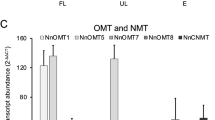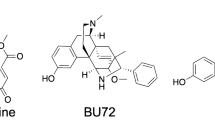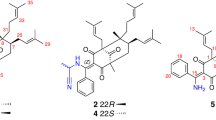Abstract
Ingestion of alkaloid metabolites from the bark of Galbulimima (GB) sp. leads to psychotropic and excitatory effects in humans1,2,3,4. Limited, variable supply of GB alkaloids5, however, has impeded their biological exploration and clinical development6. Here we report a solution to the supply of GB18, a structural outlier and putative psychotropic principle of Galbulimima bark. Efficient access to its challenging tetrahedral attached-ring motif required the development of a ligand-controlled endo-selective cross-electrophile coupling and a diastereoselective hydrogenation of a rotationally dynamic pyridine. Reliable, gram-scale access to GB18 enabled its assignment as a potent antagonist of κ- and μ-opioid receptors—the first new targets in 35 years—and lays the foundation to navigate and understand the biological activity of Galbulimima metabolites.
This is a preview of subscription content, access via your institution
Access options
Access Nature and 54 other Nature Portfolio journals
Get Nature+, our best-value online-access subscription
$29.99 / 30 days
cancel any time
Subscribe to this journal
Receive 51 print issues and online access
$199.00 per year
only $3.90 per issue
Buy this article
- Purchase on Springer Link
- Instant access to full article PDF
Prices may be subject to local taxes which are calculated during checkout




Similar content being viewed by others
Data availability
All data are made available in the main text or the Supplementary Information, including experimental procedures, copies of NMR spectra and X-ray structure reports. Details regarding materials and methods for all biological assays are available on the PDSP website https://pdsp.unc.edu/ims/investigator/web/. Structural parameters are available from the Cambridge Crystallographic Data Centre (CCDC) under the following reference numbers: SI-2, 2099462; 6, 2096777; 8, 2156368; 3, 2156367; endo-2, 2096779; endo-2·HCl, 2101251; exo-2, 2099728; 11·H2O, 2105522; 12·(CH2Cl2)0.5, 2145022; 14, 2118272; rac-1, 2143708; (+)-1, 2149782; (−)-1, 2086615; ent-2-epi-6-epi-1·HCl, 2099978; L8·HCl·H2O, 2105525.
Code availability
Code used to generate Fig. 4c,d is available in the Supplementary Information (page 72).
References
Thomas, B. Galbulimima belgraveana (F. Muell) Sprague, galbulimima agara. Eleusis J. Psychoact. Plants Compd. 2, 82–88 (1999).
Thomas, B. Psychoactive properties of Galbulimima bark. J. Psychoact. Drugs 37, 109–111 (2005).
Thomas, B. Galbulimima bark and ethnomedicine in Papua New Guinea. P. N. G. Med. J. 49, 57–59 (2006).
Thomas, B. Psychoactive plant use in Papua New Guinea. Sci. New Guin. 25, 33–59 (2000).
Binns, S. et al. The chemical constituents of Galbulimima species. Aust. J. Chem. 18, 569–573 (1965).
Rinner, U. Galbulimima alkaloids. Alkaloids Chem. Biol. 78, 109–166 (2017).
Lan, P., Herlt, A. J., Willis, A. C., Taylor, W. C. & Mander, L. N. Structures of new alkaloids from rain forest trees Galbulimima belgraveana and Galbulimima baccata in Papua New Guinea, Indonesia, and Northern Australia. ACS Omega 3, 1912–1921 (2018).
Chaudhary, N. K., Taylor, W. C., Mander, L. N. & Karuso, P. Isolation and structure elucidation of additional alkaloids from the tropical rainforest tree Galbulimima baccata. J. Nat. Prod. 84, 2525–2535 (2021).
Collins, D. J., Culvenor, C. C. J., Lamberton, J. A., Loder, J. W. & Price, J. R. in Plants for Medicines 71–106 (CSIRO, 1990).
Anwar-ul, S., Gilani, H. & Coblin, L. B. The cardio-selectivity of himbacine: a muscarine receptor antagonist. Naunyn Schmiedebergs Arch. Pharmacol. 332, 16–20 (1986).
Chackalamannil, S., Doller, D., McQuade, R. & Ruperto, V. Himbacine analogs as muscarinic receptor antagonists––effects of tether and heterocyclic variations. Bioorg. Med. Chem. Lett. 14, 3967–3970 (2004).
Sheardown, M. J. Muscarinic M1 receptor agonists and M2 receptor antagonists as therapeutic targets in Alzheimer’s disease. Expert Opin. Therap. Patents 12, 863–870 (2002).
WoldeMussie, E. & Ruiz, G. Method for reducing intraocular pressure in the mammalian eye by administration of muscarine antagonists. US patent 5716952 (1998).
Ritchie, E. & Taylor, W. C. Chapter 14 The Galbulimima alkaloids. Alkaloids Chem. Physiol. 9, 529–543 (1967).
Bradford, T. A. et al. The structures of four new himbacine-like Galbulimima alkaloids. Tetrahedron Lett. 52, 188–191 (2011).
Böttcher, T. An additive definition of molecular complexity. J. Chem. Inf. Model. 56, 462–470 (2016).
Larson, K. K. & Sarpong, R. Total synthesis of alkaloid (±)-G. B. 13 using a Rh(I)-catalyzed ketone hydroarylation and late-stage pyridine reduction. J. Am. Chem. Soc. 131, 13244–13245 (2009).
Landwehr, E. M. et al. Concise syntheses of GB22, GB13 and himgaline by cross-coupling and complete reduction. Science 375, 1270–1274 (2022).
Klix, R. C. & Bach, R. D. 1,2-Carbonyl migrations in organic synthesis. An approach to the perhydroindanones. J. Org. Chem. 52, 580–586 (1987).
Torii, S., Okumoto, H., Nakayasu, S. & Kotani, T. Hydrogenolysis of α,β-epoxyketone and ester to aldol in Pd(0)/HCOOH/Et3N and H2/Pd/C reduction media. Chem. Lett. 18, 1975–1978 (1989).
Danheiser, R. L., Carini, D. J. & Basak, A. (Trimethylsilyl)cyclopentene annulation: a regiocontrolled approach to the synthesis of five-membered rings. J. Am. Chem. Soc. 103, 1604–1606 (1981).
Ma, X., Dang, H., Rose, J. A., Rablen, P. & Herzon, S. B. Hydroheteroarylation of unactivated alkenes using N-methoxyheteroarenium salts. J. Am. Chem. Soc. 139, 5998–6007 (2017).
Fu, G. C. Transition-metal catalysis of nucleophilic substitution reactions: a radical alternative to SN1 and SN2 processes. ACS Cent. Sci. 3, 692–700 (2017).
Blackburn, J. M. & Roizen, J. L. Catalytic strategies to convert 2‐halopyridines to 2-alkylpyridines. Asian J. Org. Chem. 8, 920–930 (2019).
Nimmagadda, S. K. et al. Development and execution of an Ni(II)-catalyzed reductive cross-coupling of substituted 2-chloropyridine and ethyl 3-chloropropanoate. Org. Process Res. Dev. 24, 1141–1148 (2020).
Everson, D. A. & Weix, D. J. Cross-electrophile coupling: principles of reactivity and selectivity. J. Org. Chem. 79, 4793–4798 (2014).
Poremba, K. E., Dibrell, S. E. & Reisman, S. E. Nickel-catalyzed enantioselective reductive cross-coupling reactions. ACS Catal. 10, 8237–8246 (2020).
Zhang, P., Le, C. & Macmillan, D. W. C. Silyl radical activation of alkyl halides in metallaphotoredox catalysis: a unique pathway for cross-electrophile coupling. J. Am. Chem. Soc. 138, 8084–8087 (2016).
Hansen, E. C., Li, C., Yang, S., Pedro, D. & Weix, D. J. Coupling of challenging heteroaryl halides with alkyl halides via nickel-catalyzed cross-electrophile coupling. J. Org. Chem. 82, 7085–7092 (2017).
Anka-Lufford, L. L., Huihui, K. M. M., Gower, N. J., Ackerman, L. K. G. & Weix, D. J. Nickel-catalyzed cross-electrophile coupling with organic reductants in non-amide solvents. Chem. Eur. J. 22, 11564–11567 (2016).
Charboneau, D. J. et al. Tunable and practical homogeneous organic reductants for cross-electrophile coupling. J. Am. Chem. Soc. 143, 21024–21036 (2021).
Green, S. A., Huffman, T. R., McCourt, R. O., van der Puyl, V. & Shenvi, R. A. Hydroalkylation of olefins to form quaternary carbons. J. Am. Chem. Soc. 141, 7709–7714 (2019).
Shevick, S. L., Obradors, C. & Shenvi, R. A. Mechanistic interrogation of Co/Ni-dual catalyzed hydroarylation. J. Am. Chem. Soc. 140, 12056–12068 (2018).
Shevick, S. L. et al. Catalytic hydrogen atom transfer to alkenes: a roadmap for metal hydrides and radicals. Chem. Sci. 11, 12401–12422 (2020).
Hansen, E. C. et al. New ligands for nickel catalysis from diverse pharmaceutical heterocycle libraries. Nat. Chem. 8, 1126–1130 (2016).
Boger, D. L. The difference a single atom can make: synthesis and design at the chemistry−biology interface. J. Org. Chem. 82, 11961–11980 (2017).
Glorius, F., Spielkamp, N., Holle, S., Goddard, R. & Lehmann, C. W. Efficient asymmetric hydrogenation of pyridines. Angew. Chem. Int. Ed. 43, 2850–2852 (2004).
Welin, E. R. et al. Concise total syntheses of (−)-jorunnamycin A and (−)-jorumycin enabled by asymmetric catalysis. Science 363, 270–275 (2019).
Horii, Z. et al. Synthesis and stereochemistry in B/C ring juncture of lactamcarbinol A, a degradation product of securinine. Chem. Pharm. Bull. 13, 22–26 (1965).
Besnard, J. et al. Automated design of ligands to polypharmacological profiles. Nature 492, 215–220 (2012).
Kroeze, W. K. et al. PRESTO-Tango as an open-source resource for interrogation of the druggable human GPCRome. Nat. Struct. Mol. Biol. 22, 362–369 (2015).
Stevens, R. C. et al. The GPCR Network: a large-scale collaboration to determine human GPCR structure and function. Nat. Rev. Drug Discov. 12, 25–34 (2013).
Acknowledgements
Ki determinations, receptor-binding profiles, agonist and antagonist functional data were generously provided by the National Institute of Mental Health's Psychoactive Drug Screening Program, contract no. HHSN-271-2018-00023-C (NIMH PDSP). The NIMH PDSP is directed by B. L. Roth at the University of North Carolina at Chapel Hill and Project Officer J. Driscoll at NIMH, Bethesda. We thank J. Chen, B. Sanchez and Q. N. Wong for assistance with separations and analysis. M. Gembicky, E. Samolova, J. Bailey and the entire UCSD Crystallography Facility are acknowledged for X-ray crystallographic analysis. L. Pasternack and D.-H. Huang are acknowledged for assistance with NMR spectroscopy. We thank S. W. M. Crossley, M. D. Palkowitz, B. P. Smith and G. Tong for proofreading. Support was provided by the National Institutes of Health (R35 GM122606; S10 OD025208), the National Science Foundation (CHE 1856747) and the Skaggs Graduate School (fellowship to S.W.).
Author information
Authors and Affiliations
Contributions
R.A.S. and S.W. conceived the project. R.A.S. directed the research. R.A.S. and S.W. composed the manuscript and S.W. compiled the supplementary information. S.W. executed all the experimental work. R.A.S. analysed data and parameterized the synthesis.
Corresponding author
Ethics declarations
Competing interests
A provisional patent has been filed by S.W. and R.A.S.: US patent application no. 63/301,677.
Peer review information
Peer review information
Nature thanks the anonymous reviewers for their contribution to the peer review of this work.
Additional information
Publisher’s note Springer Nature remains neutral with regard to jurisdictional claims in published maps and institutional affiliations.
Supplementary information
Supplementary Information
Experimental procedures, spectral data, biological assay data, chemical informatics data and code, references and crystallographic data.
Rights and permissions
About this article
Cite this article
Woo, S., Shenvi, R.A. Synthesis and target annotation of the alkaloid GB18. Nature 606, 917–921 (2022). https://doi.org/10.1038/s41586-022-04840-9
Received:
Accepted:
Published:
Issue Date:
DOI: https://doi.org/10.1038/s41586-022-04840-9
This article is cited by
Comments
By submitting a comment you agree to abide by our Terms and Community Guidelines. If you find something abusive or that does not comply with our terms or guidelines please flag it as inappropriate.



